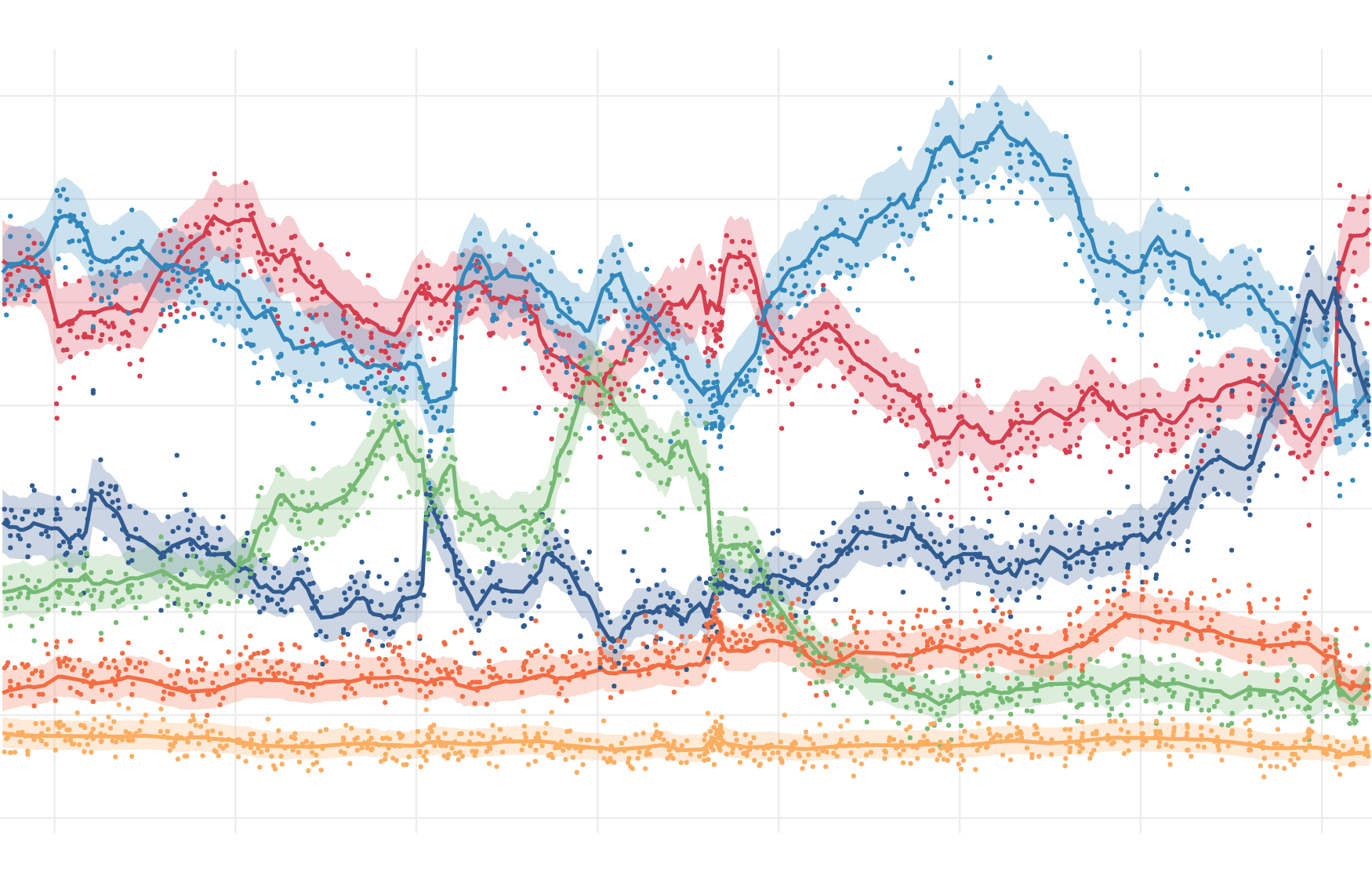Norwegian Poll Tracker
This page estimates the public support of Norwegian political parties based on opinion polls. The page is updated daily and reports estimates for each week from the election of 2013 until now.

How popular are the competing blocks?
The plot shows weekly levels of support in the form of predicted vote shares. Uncertainty is illustrated by 90% prediction intervals.
If an election were held today, the vote share of the conservative block would be expected to lie between 44.3 and 48.5% with a 90% probability. The Labor Party (Ap), the Centre Party (Sp), and the Socialist Left Party (SV) would be expected to receive between 39.4 and 43.6% of the votes. Adding the Green Party (MDG) and the Red Party (R) to this coalition, their vote share would be expected to lie between 47.2 and 51.5%.
What about other coalitions?
The plot shows weekly levels of support in the form of predicted vote shares. Uncertainty is illustrated by 90% prediction intervals.
The Labor Party (Ap) and the Centre Party (Sp) would jointly be expected to receive between 32.2 and 36.4% of the votes if an election were held today. This entails a loss of approximately 5.5 percentage points since the last election. The Convervative Party (H) and the Progress Party (Frp) would be expected to receive between 36.1 and 40.3% of the votes, which implies a gain of approximately 6.2 percentage points since the last election.
The Socialist Left Party (SV), the Green Party (MDG), and the Red Party (R) have seen their joint vote share increase over the last ten years. Compared to the election of 2013, they would be expected to gain approximately 7 percentage points if an election were held today.
Who will win a parliamentary majority?
The plot shows the probability that a party constellation would get a majority if an election had been held during a given week. To show or hide a group, click on it in the list above the plot.
The conservative block would have had a 14.3% probability of winning a parliamentary majority if an election were held today. The equivalent probability for a coalition consisting of the Labor Party (Ap), the Centre Party (Sp), and the Socialist Left Party (SV) is less than 5%. Adding the Green Party (MDG) and the Red Party (R) to the coalition increases the probability to 85.7%.
How popular are the parties?
The plot shows weekly levels of support in the form of predicted vote shares. Uncertainty is illustrated by 90% prediction intervals.
If an election were held today, the Labor Party (Ap), at 26.1 to 30%, would likely receive the largest vote share, ahead of the Progress Party (Frp), at 20.3 to 24%. The Progress Party (Frp) would likely see the largest gains compared to the last election, adding between 8.7 and 12.4 percentage points to its vote share. The Centre Party (Sp) would likely see the largest losses, dropping between 6.2 and 8.2 percentage points compared to the last election.
Who will get above the 4% threshold?
The plot shows the probability that a party would get above the 4% threshold if an election had been held during a given week.
The Red Party (R) would have had a greater than 95% probability of getting more than 4% of the national vote if an election were held today. The equivalent probability for the Liberal Party (V) is 92.8%. For the Christian Democratic Party (KrF) it is 8.2%, and for the Green Party (MDG) less than 5%.
How many seats will each party get?
The plot shows weekly levels of support in the form of predicted parliamentary seats. Uncertainty is illustrated by 90% prediction intervals.
If an election were held today, the Labor Party (Ap) would likely become the largest party in parliament, winning 49 to 56 seats, ahead of the Progress Party (Frp), at 39 to 45 seats. The Progress Party (Frp) would be expected to gain the most seats, adding between 18 and 24 compared to the last election. The Centre Party (Sp) would likely lose the most, obtaining 15 to 19 fewer seats.
How do the polls look?
The reported date for each poll is the midpoint between the start and end of the data collection. The trend lines represent predicted vote shares with 90% prediction intervals.
In addition to national polls, the plot above shows the estimated trends of public support. Because the model corrects for differences between polls and actual results in previous elections, some trends are adjusted slightly up or down relative to a simple moving average of the polls.
How fragmented is the party system?
The plot shows expected fragmentation for a predicted election result during a given week. Fragmentation is measured as Shannen entropy with logarithm base ten, which means it theoretically varies between zero and one for a system with ten parties. Uncertainty is illustrated by 90% prediction intervals.
The Norwegian party system has grown more fragmented over time, and this trend has continued during the last decade. On a scale from zero to one, fragmentation among voters was approximately 0.65 in the 1950s, while it was 0.89 at the 2021 election. Fragmentation is somewhat lower in parliament than among voters, due to the design of the electoral system.
About this website
To keep track of new polls, this project relies on Poll of polls and the project might not have been feasible without their effort to systematize the polls. The idea behind this project is to complement their contribution by going further in terms of modeling party support and predicting election results.
Further information about this site can be found here.